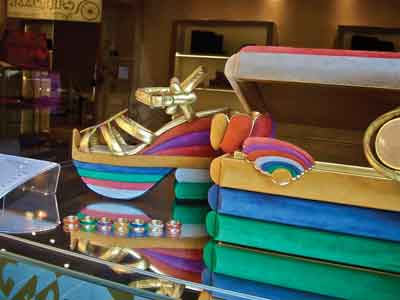My mother in law remembers shopping for shoes at Ferragamo in Florence many moons ago and Salvatore Ferragamo would be there with his leather apron around his waist. The shop is still the same, located in the magnificent Palazzo Spini Feroni, built in the 13th century by Geri Spini, in the most elegant area of the city. It is today the flagship store for their international fashion brand. Ferragamo is still family-run by Salvatore’s children and some of the grandchildren. After Salvatore’s death in 1960, at the age of 62, his wife Wanda, who had never worked in her life, and their youngest child was only two years old, immediately took over the company’s reins and has never looked back. She expanded the brand to clothing and other accessories, and it has gone from strength to strength.
The Ferragamos are considered to be one of the leading Florentine families, but neither Salvatore nor Wanda were native Tuscans. Salvatore hails from a small village called Bonito in the Campania region in Southern Italy and was the eleventh of fourteen children. He made his first pair of shoes for his sister at nine years old, for her to wear to communion. At eleven he was apprenticed to a shoemaker in Naples and later opened a small shop in his parents’ house.
At fourteen he went to America, following two of his brothers who were in Boston working in a cowboy boot making factory. He convinced them to go to California and they opened a shop in Hollywood doing shoe repairs and later making custom made shoes. Thirteen years later, in 1927, Salvatore returned to Italy having made his name among the stars and the rich and famous. His shoes were renowned for creativity in design and innovation, but he was always interested in the engineering of the shoe for comfort, to the point of enrolling in anatomy classes at the university of California. One of his inventions was the steel arch lifting the weight from the ball of the foot to the arch.
He chose Florence as his home due to the long standing excellence in leather craftsmanship in the city. During the war years, due to the lack of leather and steel, he used cork and raffia and hemp. He invented the wedge heel in the 1930s for greater comfort and increased elegance. His clientele included Greta Garbo, Audrey Hepburn and Ingrid Bergman, to name a few. In 1936 he rented two shops on the ground floor of the Palazzo Spini Feroni; two years later he bought the whole building.
Wanda, his wife, was 20 years younger than Salvatore. She too was from Campania and was a great partner and support to him when he was alive and a born matriarch for the family and company after his death. Their eldest daughter, Fiamma (1941-1998), followed in her father’s creative footsteps and designed the Vara grossgrain ribbon flat shoe in 1978, which is an icon in the Ferragamo history and a staple in the stores today.
By Freya Middleton
www.freyasflorence.com

